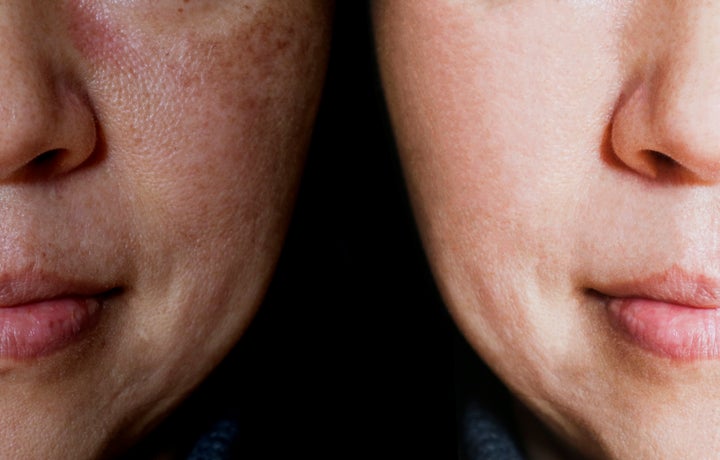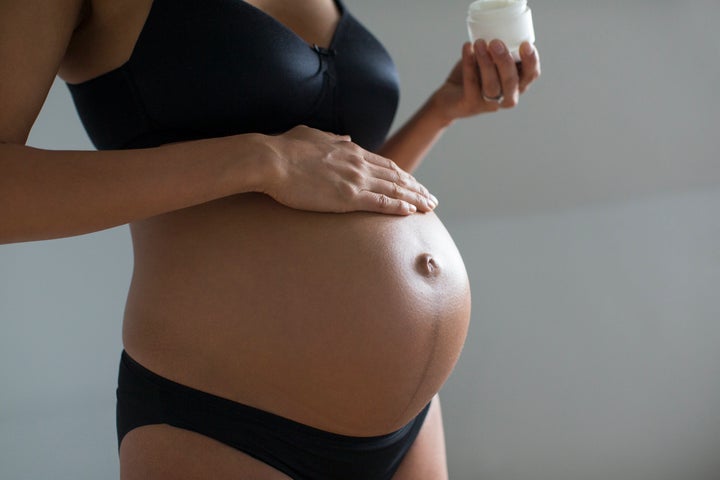
Between breastfeeding attempts, hair loss and recovering from delivery, the postpartum period marks a time of drastic change in the body.
One area you might not have expected to undergo change? Your skin. While you may have had a “pregnancy glow” pre-birth, you might be dealing with a whole host of skin issues postpartum. According to Laura Erlich, a holistic fertility and obstetric specialist, you have fluctuating hormones to thank for that.
“Right after birth, there tends to be a rush of adrenaline and endorphins (which help with the initial bonding and recovery), but within a few days postpartum, there’s a sharp drop in pregnancy hormones,” Erlich explains.
Add to this the “baby blues” – a normal but still destabilising few days that can leave you feeling weepy and down, which can cause an increase in stress hormones like cortisol.
“This combination of events is extremely depleting for the body, and can lead to lots of issues including skin outbreaks, dryness and rashes,” Erlich says.
Thankfully, there are ways to manage these issues. Below are five of the most common postpartum skin conditions, and how to deal with them.
Melasma
Melasma, also referred to as “pregnancy mask,” is a condition that involves the darkening of the skin as a result of increased melanin production. “It sometimes appears as spots on the face, an increase in freckles, or a darkening of the skin around the mouth,” said Erlich, who notes that this same melanin manifests in the linea alba, the dark line that appears on the abdomen from the navel to the pubic bone during pregnancy.

Though melasma is a stubborn form of hyperpigmentation, it usually resolves itself once your hormone levels reset. Still, Geeta Yadav, a board-certified dermatologist, says the best course of action when it comes to managing melasma is sun protection, as UV exposure is a trigger for the condition.
“Stay out of the sun as much as possible and be sure to load up on [SPF 30] when sun exposure is unavoidable, supplementing your sun protection with a big floppy hat and oversized sunglasses,” Yadav says. Also, avoid things like hot yoga and saunas, as heat can exacerbate the condition.
Eczema
Eczema, an inflammatory skin condition that results in dryness and itchiness, often arises due to the rapid decline of pregnancy hormones as well as the changes in the immune system that occur postpartum, Erlich says. Also, many new mothers feel stressed during the first few weeks of their baby’s life, and stress has been shown to exacerbate eczema. Erlich notes that while symptoms of eczema often resolve after birth, that isn’t always the case, especially if it was a condition that existed pre-pregnancy.
To manage the skin condition, consider the foods you’re consuming. Erlich recommends eating a nutrient-dense diet and avoiding inflammatory foods like white flour, dairy (if you are sensitive) and anything processed, especially processed sugar. Also, steer clear of showering or bathing in hot water (as this can cause eczema to flare up), and use skin care products that contain soothing ingredients like colloidal oatmeal and aloe vera.
Acne
Postpartum acne can take the form of cysts, blackheads, whiteheads and pustules. There are several reasons you might be experiencing postpartum acne. The main one? The sudden drop in oestrogen along with a rise in prolactin following birth. As with eczema, the rise in cortisol levels postpartum can also lead to acne. “Cortisol is a stress hormone that increases the activity of the sebaceous glands in the skin, which can increase sebum production and can cause an outbreak,″ Erlich says.
To keep postpartum acne in check, maintain a regular routine of cleansing, toning, exfoliating and moisturising to help rebalance your skin. Many tried-and-true blemish-fighting skin care ingredients – including retinoids and BHAs like salicylic acid – are off limits if you’re breastfeeding. Instead, opt for benzoyl peroxide or azelaic acid, which Yadav notes is great for battling breakouts and “may even help soothe the inflammation caused by blemishes, reducing redness and tenderness.”

Stretch marks
When it comes to stretch marks, Yadav says that hormonal fluctuations during pregnancy can cause the bonds of your collagen and elastin fibres to weaken, which makes them more susceptible to damage.
“Simultaneously, your skin is forced to stretch very rapidly and faster than it can adjust,” Yadav says. “This causes those fibres to tear, creating lines under your skin’s surface.”
Stretch marks are most commonly found on areas where your skin was forced to stretch the most (ie. the breasts and belly), though they can also be found on the upper arms, hips and thighs.
Unfortunately, once the stretch marks appear, the damage has been done and can’t be reversed, Yadav says. That said, stretch marks usually become less apparent over time. “Topical treatments that include vitamin A and glycolic acid may improve their appearance, as can collagen induction therapy such as radiofrequency microneedling,” she notes.
Polymorphic eruption of pregnancy
While PEP is a common condition of pregnancy, it can also appear postpartum – usually immediately after delivering. “The condition is characterised by itchy red plaques that initially appear in the abdominal region, typically sparing the area around the belly button,” Yadav says. “Risk factors for PEP include rapid, excessive weight gain, so working on maintaining a balanced diet during pregnancy is key.”
PEP tends to affect women the first time they are pregnant and usually doesn’t recur in subsequent pregnancies, Yadav says. It can take about four weeks to resolve, and common treatments include topical corticosteroids (which you can get OTC or in prescription-strength concentrations from your dermatologist) as well as oral antihistamines. As with eczema, a cool bath with colloidal oatmeal can also feel extremely soothing.